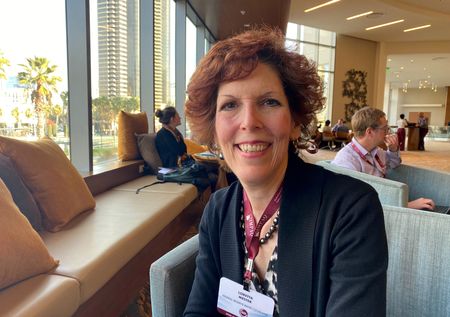By Michael S. Derby
NEW YORK (Reuters) -Cleveland Federal Reserve President Loretta Mester said on Thursday the U.S. central bank still has more interest rate increases ahead of it, while noting the aggressive move to boost the cost of borrowing over the last year to quash high inflation is nearing its end.
“Demand is still outpacing supply in both product and labor markets and inflation remains too high,” Mester said in a speech to the Akron Roundtable, a community forum in Akron, Ohio.
“In order to put inflation on a sustained downward trajectory to 2%, I anticipate that monetary policy will need to move somewhat further into restrictive territory this year, with the fed funds rate moving above 5% and the real fed funds rate staying in positive territory for some time,” Mester said, referring to the central bank’s benchmark overnight interest rate.
But she also noted that supply imbalances in the economy are on the mend, and with the cumulative impact of Fed rate rises weighing on the economy, “we are much closer to the end of the tightening journey than the beginning.” Mester added what happens next with rates will depend on the economy.
Mester, who does not have a vote on the rate-setting Federal Open Market Committee this year, spoke less than two weeks before the Fed’s May 2-3 policy meeting. The central bank is widely expected to hike rates a final time at that meeting, lifting its policy rate by a quarter of a percentage point to the 5.00%-5.25% range.
The Cleveland Fed chief said banking problems that kicked off last month could help add to a tightening in financial conditions that could affect the choices central bankers will make.
Noting a need to be “prudent” with policy, Mester said this possible change in financial conditions “would work in the same direction as tighter monetary policy,” which the Fed will need to take stock of “to help us calibrate the appropriate path of monetary policy going forward.”
Mester said she expects the unemployment rate, which is currently 3.5%, to rise to between 4.5% and 4.75%. She sees inflation, which was running at a 5% clip on a year-over-year basis in February based on the Fed’s preferred measurement, easing to 3.75% this year and hitting the central bank’s 2% target in 2025.
In response to an audience question after her formal remarks, Mester said she believes the U.S. is likely to escape a recession, even as growth probably cools quite a bit as a result of Fed policy actions.
“The ‘soft landing,’ of course, is what we’re aiming for,” Mester said, referring to a scenario in which monetary tightening slows the economy, and inflation, without triggering a recession. “In this environment, I do think we’re going to have very slow growth – I think growth will be well below 1%.”
With activity that tepid, it would be skirting outright contraction, Mester said. But even if a recession happens, she said she does not believe it would be a deep one amid an otherwise resilient economy.
(Reporting by Michael S. Derby; Editing by Paul Simao)





